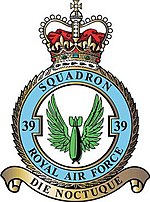No. 39 Squadron RAF
| No. 39 Squadron RAF | |
|---|---|
 |
|
| Active | 15 April 1916 - 17 November 1918 1 July 1919 - 8 September 1946 1 April 1948 - 28 July 2006 1 Jan 2007 - date |
| Role | Reconnaissance |
| Garrison/HQ | RAF Waddington |
| Motto(s) |
Latin: Die noctuque ("By day and night") |
| Equipment | 5 x MQ-9 Reaper |
| Battle honours | Home Defence 1916–1918*, North West Frontier 1930-1931, Mohmand 1933, North West Frontier 1935-1939, East Africa 1940*, Egypt and Libya 1940–1943*, Greece 1941, Mediterranean 1941–1943*, Malta 1942*, North Africa 1942–1943*, South East Europe 1944–1945, Iraq 2003 Honours marked with an asterix are emblazoned on the Squadron standard |
| Insignia | |
| Squadron badge heraldry | A winged bomb |
| Squadron Codes |
SF Apr-Sep 1939 (Allocated but probably not carried) XZ Sep 1939 - Dec 1940 AA-AZ Carried on Canberras |
No. 39 Squadron of the Royal Air Force has operated the MQ-9 Reaper since 2007. It currently operating from RAF Waddington.
39 Squadron was founded at Hounslow Heath Aerodrome in April 1916 with B.E.2s and Royal Aircraft Factory B.E.12s in an attempt to defend against German Zeppelin raids on London. It achieved its first success on the night of 2/3 September 1916, when Lieutenant William Leefe Robinson shot down the German Airship Schütte-Lanz SL11, being awarded the Victoria Cross for this action. On 23 September 1916, the German Navy launched another Zeppelin raid against London. Responding to this raid, 2nd Lieutenant Frederick Sowrey of 39 Squadron shot down Zeppelin L.32, while another 39 Squadron B.E.2 engaged Zeppelin L.33, already damaged by anti-aircraft fire, with L.33 force landing at Little Wigborough, Essex, and being destroyed by its crew. On the night of 1/2 October 1916, 2nd Lieutenant W. L. Tempest of 39 Squadron, flying a B.E.2c, spotted Zeppelin L.31 illuminated by searchlights over southwest London and shot it down with the loss of the entire airship crew.
The Squadron continued in the defence of London, supplementing its B.E.2s and B.E.12s with three Royal Aircraft Factory S.E.5s to help deal with daylight attacks by German Gotha bombers, with at least one Armstrong Whitworth F.K.8 also operated by the unit. The squadron re-equipped with Bristol F.2 Fighters in September 1917, but had no more success against German raiders until the night of 19/20 1918, when a 39 Squadron Bristol Fighter shot down a Gotha bomber. In October 1918 it was re-equipped with Royal Aircraft Factory F.E.2b aircraft and sent to France for night bombing, but was disbanded five days after the Armistice.
...
Wikipedia
